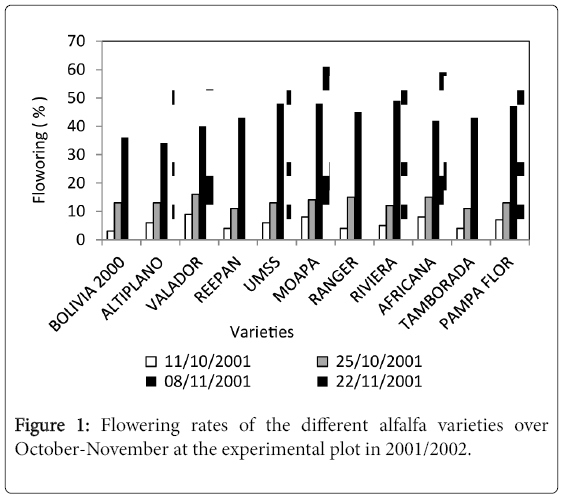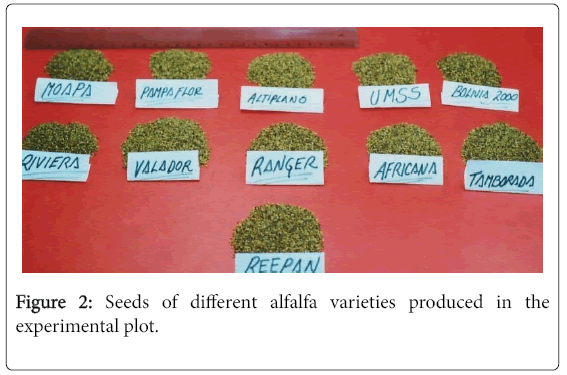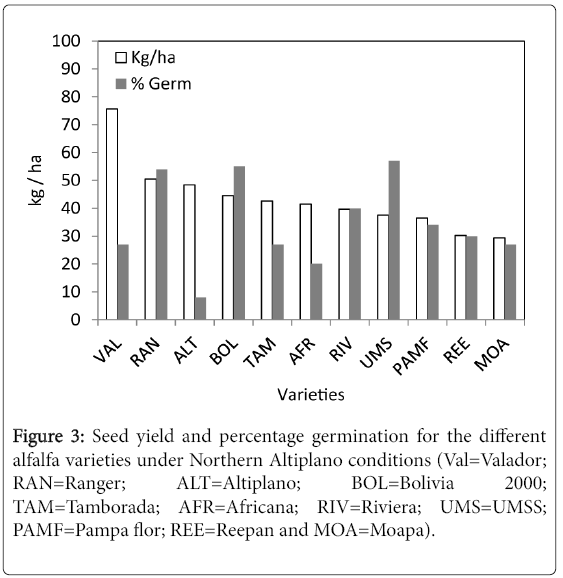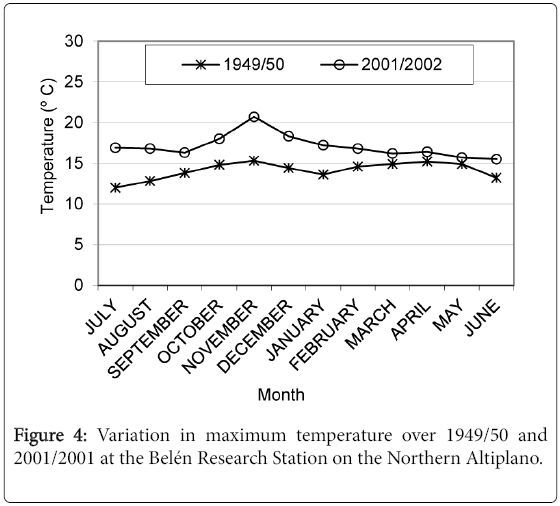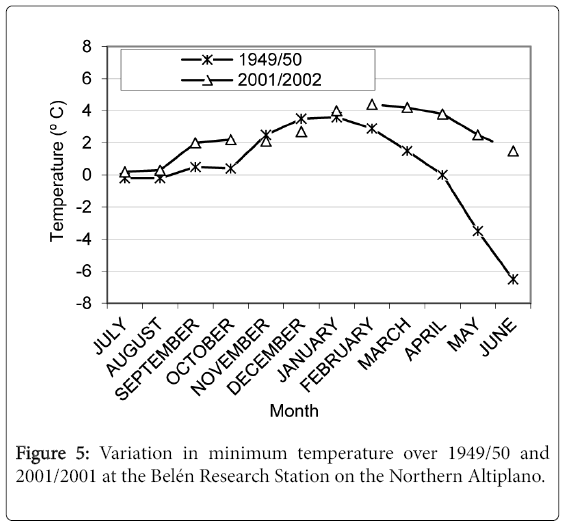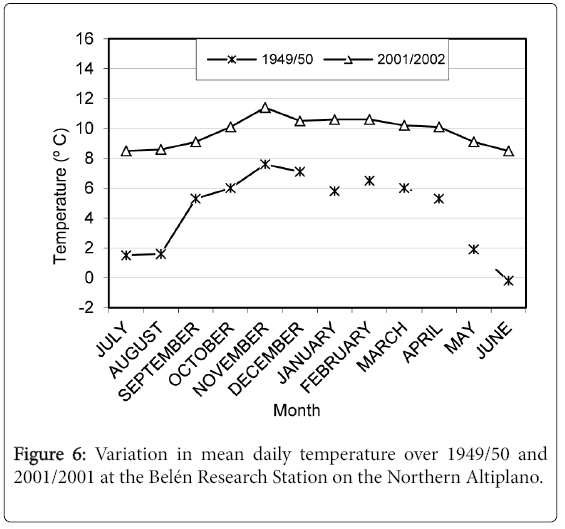Improvements in Alfalfa (Medicago sativa L.) Seed Production with Warming Climatic Conditions on the Northern Altiplano of La Paz, Bolivia
Received: 17-Jan-2018 / Accepted Date: 31-Jan-2018 / Published Date: 07-Feb-2018 DOI: 10.4172/2329-8863.1000337
Abstract
Alfalfa (Medicago sativa L.) has been cultivated since 1948 on the Northern Altiplano of La Paz, Bolivia. It is grown largely for forage rather than seed since the cold negatively affects fruit production. During the 2001/2002 season, an experimental plot with a complete random block design (5 × 2 m) and four replicates, was established at the Estación Experimental Belén (the Belén Research Station) on the Northern Altiplano at an altitude of 3824 m, in which 11 varieties of alfalfa were planted with the aim of examining their seed-producing potential. These crops were left uncut between sprouting (August) and harvest. Maximum and minimum and mean daily temperatures were recorded over the growing season, and compared to those recorded for 1949/50 (just after alfalfa was first introduced). All the varieties showed good percentage flowering rates (mean 80%). In May 2002, 1 m2 samples were harvested from each experimental unit and air dried in the normal environment. The seeds were separated out by threshing, weighed, and the percentage able to germinate determined in the laboratory. The variety Valador produced the greatest seed yield (76 kgha-1) followed by Ranger (51 kg.ha-1). Historical records show no alfalfa seed to have been produced in the late 1940s/early 1950s. The variety UMSS produced the seeds that most often germinated (57%); those of the other varieties were commonly hard or immature. The temperatures recorded for the 2001/2002 season were notably warmer than those for 1949/50; temperature is known to influence alfalfa seedproducing capacity. The present results show that alfalfa seed can now be produced on the Northern Altiplano. This might be due to the higher temperatures currently recorded in the region, which might increase the presence of pollinating insects as well as improve plant and seed metabolism.
Keywords: Alfalfa; Altiplano; Seed production; Seed quality; Climate change
Introduction
Alfalfa (Medicago sativa L.) was introduced into the valleys of Bolivia during colonial times with the aim of providing forage for working animals [1]. However, this crop was not grown on the Altiplano of La Paz until the 1940s. Following the inauguration of the Estación Experimental del Altiplano (The Altiplano Research Station) in 1948, however, different varieties of alfalfa from Argentina, Peru, the USA and France were introduced into the region [2]. The latter report records that "fields of alfalfa are grown by farmers on the Northern Altiplano".
Mostly concentrated in the Central and Northern Altiplano, the area under alfalfa on the Altiplano of La Paz rose from 6900 ha in 1990 to 37,000 in 2015 [3], an increase that has stimulated the demand for seed considerably. Since 1960, most seed has been imported from Peru, with a little Bolivian seed brought in from Cinti-Tarija [4]. According to the Annual Reports of the Programa Nacional de Semillas [5,6], for example, 54 metric tonnes of alfalfa seed of different varieties were imported in 2002, and 17 metric tonnes in 2003. Since 1972, the Bolivian company Semillas Forrajeras (SEFO) has met some of this demand.
Alfalfa seed production was never a goal on the Altiplano; its cold environmental conditions render flowering and fruit production very difficult. Gandarillas [4] reported that in 1951 “while flowering did occur between November and January, none of the varieties examined produced seed, obliging that it be produced in warmer areas or be imported".
In 2000/2001 the alfalfa crops of the Northern Altiplano were affected by pests (butterflies, grasshoppers and aphids) as well as by mildew (Peronospora trifoliorum ), the fungus Pseudopeziza sp., and other pathogens usually seen in warmer climes [7]. Interestingly, in 2001, some Ranger variety alfalfa fruit set for the first time at the Estación Experimental Belén (Belén Research Station) [7]. The aims of the present work were therefore to: i) Assess the seed-producing capacity of different varieties of alfalfa when grown on the Northern Altiplano of La Paz, ii) and to compare current and historic climate records for the region.
Methods and Materials
Location
This work was performed between 2001 and 2002 at the Belén Research Station (16°03' 25''S, 68°41''45''W; altitude 3824 m) which is situated 3 km from the town of Achacachi in the Province of Omasuyos, Department of La Paz (Northern Altiplano) (Figure 1). The rainfall in the area is 450-600 mm per annum, falling mostly in November-March, with January-March the months of greatest precipitation. Snow falls in an isolated fashion between July and September.
Experimental plot
In 2001 an experimental plot was established in which 11 varieties of alfalfa were planted: 1. Valador, 2. Ranger, 3. Altiplano, 4. Bolivia 2000, 5. Tamborada, 6. Africana, 7. Riviera, 8. UMSS, 9. Pampa flor, 10. Reepan and 11. Moapa. Seed for all these varieties was provided by the Centro de Investigaciones Forrajeras (Centre for Forage Research) (CIF, Cochabamba, Bolivia). The plot had a complete random block design with four replicates (bocks) measuring 5 × 2 m. No plant protection products were used, nor were any forage cut, between sprouting (from August 2001) and harvest (May 2002). The maximum, minimum and mean daily temperatures were measured throughout the growth period, and compared to historic data for 1949/50 (just after the introduction of the crop to the Altiplano) recorded by the Altiplano Research Station, i.e., the predecessor of the Belén Research Station.
Flowering and yield
Flowering was monitored between October and November 2001 over 1 m2 squares in each experimental unit. In May 2002, these same sample areas were harvested. After drying at ambient temperature in normal air, the seeds were separated by threshing and weighed (g.m-2). The germination rate for these seeds was later determined following the methods of the laboratory of the Official Seed Office of La Paz. Briefly, after eliminating impurities and all split and damaged seeds, 100 seeds per variety were placed on pieces of sterile filter paper. These were then saturated with distilled water, placed in environment chambers at 25°C for 72 h, and the number that germinated recorded.
Statistics
Data were analyzed by ANOVA, and F0.05 and F0.01 values determined.
Results
Flowering and seed yield
Flowering began in October/November, with all varieties showing 50% flowering rates after 40 days (Figure 1). All the varieties produced seed (Figure 2), although the yields differed (Figure 3). Indeed, the variety Valador produced a significantly (F0.01) greater seed yield than all others (76 kgha-1 compared to 51 kg.ha-1 for Ranger, down to 24 kgha-1 for Moapa).
Percentage germination
Figure 3 shows the percentage germination achieved by the seeds of each variety. The seeds of the varieties UMSS, Bolivia 2000 and Ranger all surpassed 50% germination (no significant differences), with UMSS reaching 57%. The remaining varieties all returned values of under 40%; their seeds were commonly hard or immature, i.e., not unviable but suffering physiological defects.
Temperature differences and possible effect on seed production
Figures 4-6 shows the variations in maximum, minimum and mean daily temperature for 1949/50 and 2001/2002 [2]. The temperatures during these years were very different; 2001/2002 was generally warmer, with a mean maximum temperature of 17.1°C compared to 14.1°C for 1949/50, and a mean minimum temperature of 2.5°C compared to 0.4°C. In addition, the 1949/50 data show a strong fall in temperature from June to January-just when alfalfa fruits would be forming. However, no such steep fall was seen in 2001/2002 (Figure 4). Finally, the mean ambient temperature was 9.8°C in 2001/2002 compared to 4.5°C in 1949/50.
Discussion
The present alfalfa seed production results differ from those reported by Gandarillas [4] who indicates that, in 1951, no seed was produced by any variety (including Ranger)-despite their flowering. This may be due to the interaction between variety and environment [8]. It should also be noted that in 1949/50, few flowers were produced [4], whereas in the present work all the varieties reached a 50% flowering rate during the warmest months.
The present seed yields were much smaller than those reported by the CIF under the conditions of the Interandean Valles area (2100-2600 m) where alfalfa seed is traditionally produced in Bolivia (Table 1). Valador produced the highest seed yield at 76 kgha-1, followed by Ranger at 51 kgha-1.
| Variety | Yield (kg.ha-1) | Origin | |
|---|---|---|---|
| CIF (*) | BELÉN | ||
| Valador | 250-400 | 76 | USA |
| Ranger | NO | 51 | USA |
| Altiplano | 400-1000 | 48 | Selection |
| Bolivia 2000 | 400-700 | 45 | Selection |
| Tamborada | 500-800 | 43 | USA |
| Africana | 250-400 | 42 | USA |
| Riviera | 300-400 | 40 | Selection |
| UMSS | 400-600 | 38 | Poly-crossing |
| Pampa flor | - | 37 | - |
| Reepan | 300-600 | 30 | Altiplano |
| Moapa | 200-350 | 29 | USA |
Table 1: Yield of alfalfa seed produced on the Northern Altiplano at the Belén Research Station, and in the Interandean Valles region by the Centro de Investigaciones Forrajeras in 2002.
The introduced varieties Altiplano and Reepan are the product of Altiplano germplasm plots that are 30 years old [9], yet they produced under 50 kgha-1 of seed. It is of particular interest that the variety Ranger was recorded capable of producing seed. According to the CIF, Ranger produces no seed in the Interandean Valles region owing to a problem of sterility, yet here on the Northern Altiplano this problem seems, at least partially, to have been overcome.
Most of the varieties examined in the present work come from the USA, where they are in fact considered old varieties. In the present work, however, they showed some promise under the conditions of the Altiplano. Barnes [10] indicates some of these varieties to have been developed in the 1950s by combining germplasm from three of more sources, including Medicago falcata, Ladak, M. varia, and Turkistani, Flemish, Chilean, Peruvian, Indian and African germplasm.
According to the CIF [9], temperature strongly affects flowering and fruit setting in alfalfa-this is why companies such as SEFO and research centres such as the CIF produce seed in the Interandean Valles region, e.g., at San Juan del Oro in Tarija (2100-2300 m) and “La Violeta” in Cochabamba (2450 m). The present results suggest, however, that the increase in temperatures (minimum, maximum and ambient) noted between 1949/50 and 2001/2002 may now allow seed to be produced more easily on the Altiplano. This may be due to improved plant/seed metabolism and a possibly greater abundance of pollinating insects. However, some other factor that was not controlled for here, e.g., amount of solar radiation, day length, presence/absence of biotic stresses, etc., may have played a role, allowing some varieties to show greater seed production potential [8].
Conclusion
The 11 varieties of alfalfa studied showed good flowering rates (over 50% in two months) and even produced seed, though less than that produced in the more suitable Interandean Valles region-with the notable exception of Ranger. The variety Valador showed the greatest seed production, and UMSS the best seed germination rates (57%), but many seeds of all varieties were hard or immature. Finally, the warmer conditions of 2001/2002 likely played a key role in the greater flowering and fruit setting seen compared to 1949/50.
Acknowledgements
The authors thank Yesmy Laredo Espinoza and Álvaro Méndez Romero of the ex-Oficina Regional de Semillas-La Paz (currently known as the Instituto Nacional de Investigaciones Agropecuarias y Forestales, INIAF), for their assistance in laboratory work. Thanks are also due to Edgar Imaña of the SENAMHI-LP for collecting the climate data for 2001/2002. We also thank Adrian Burton for editing and language assistance.
References
- Sauma G, Pizarro EY (2010) Production of forage seeds with small producers in SEFO-SAM. XI Seminar on the management and use of pastures and fodder in Animal Production Systems. Cochabamba, Bolivia.
- InformeTécnico 1949/1950 (1950) Technical Report of the Altiplano Experimental Station. Inter-American Agricultural Service. La Paz, Bolivia.
- Gandarillas H (2002) History of Research for Agricultural Development in Bolivia: Memories of a Researcher. Editora JV Cochabamba, Bolivia.
- National Seed Program Annual report (2002) National Seed Program / Ministry of Agriculture, Livestock and Rural Development. La Paz, Bolivia.
- ProgramaNacional de SemillasInformeAnual (2003) National Seed Program / Ministry of Agriculture, Livestock and Rural Development. La Paz, Bolivia.
- Morante MC (2000) Leaf spots in the cultivation of alfalfa (Medicagosativa L.) in the Northern Altiplano of La Paz, Bolivia. Belén Experimental Station. Universidad Mayor de San Andrés. La Paz, Bolivia.
- Evans LT, Fischer RA (1999) Yield Potential: Its Definition, measurement, and significance. Crop Sci 39: 1544-1551.
- Forage Research Center (2002) Description of alfalfa cultivars managed by the CIF and SEFO. University of San Andres. Cochabamba, Bolivia.
- Barnes DK (2002) My observations about a Century of Breeding and Selection in the Alfalfa Genome. Medicago genetic reports. Minnesota, USA, p: 2.
Citation: Morante MC, Lira ZC (2018) Improvements in Alfalfa (Medicago sativa L.) Seed Production with Warming Climatic Conditions on the Northern Altiplano of La Paz, Bolivia. Adv Crop Sci Tech 6: 337. DOI: 10.4172/2329-8863.1000337
Copyright: © 2018 Morante MC, et al. This is an open-access article distributed under the terms of the Creative Commons Attribution License, which permits unrestricted use, distribution, and reproduction in any medium, provided the original author and source are credited.
Select your language of interest to view the total content in your interested language
Share This Article
Recommended Journals
Open Access Journals
Article Tools
Article Usage
- Total views: 5546
- [From(publication date): 0-2018 - Dec 10, 2025]
- Breakdown by view type
- HTML page views: 4611
- PDF downloads: 935

